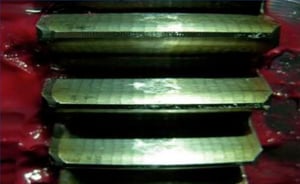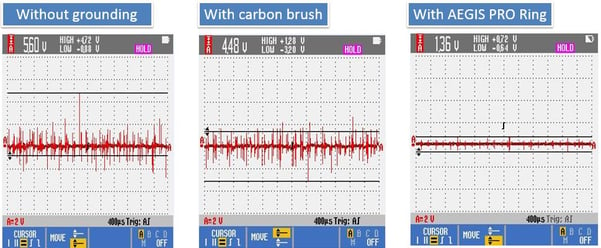Updated: February 2024
People usually have AC motors in mind when talking about shaft grounding. But a generator is just a motor running in reverse. In a motor, external electric power forces the rotor to spin. The input and output are reversed in a generator: an external source spins the rotor, producing electric power.
The High Stakes of Unprotected Equipment
Motors and their coupled equipment are vulnerable to electrical bearing damage. And so are generators and their peripheral equipment. On land, this damage can lead to unplanned downtime and colossal loss of income. But if a sea vessel's generator or gearbox fails, the ship may be left dead in the water.

Real-World Impact: A Case Study
This happened to a commercial ship when the auxiliary reduction gears that drove its generator suddenly failed (pictured). Without the gearbox, the 1.5 MW generator couldn't run, and without the generator, the ship had no electricity. The ship had to return to Shanghai for gearbox repairs. The cause was electrical arcing through the gearbox. Every day's delay cost the owners $10,000, so they had to solve this electrical problem quickly.
They called in Xview Asia, a Hong Kong-based electrical supplier. Xview found that the generator created high-frequency voltage waves that traveled down the input shaft to the gearbox. There, they discharged to ground by arcing through the gears and bearings. This type of shaft voltage would normally cause circulating currents within the generator, from shaft to frame and back. But the generator's bearings were insulated. This protected the generator from bearing damage but left the voltage to seek another path between the shaft and frame. The path it found was through the gearbox to ground.
Insulating the gearbox's bearings would not solve the problem because the gears would still be vulnerable. But grounding the generator shaft could give the shaft voltage a low-resistance path to ground. Rather than arcing through the gearbox, the voltage would bleed off harmlessly through the grounding device. So Xview tried using carbon brushes to ground the shaft, but they only reduced the maximum voltage from 5.5-6.5 volts to 4.5 (peak to peak). Carbon brushes are good at conducting direct current but much less good at conducting high-frequency alternating current.
Expert Intervention with AEGIS® Solutions
So Xview then tried an AEGIS® PRO Shaft Grounding Ring. AEGIS Rings are designed to offer low resistance to high-frequency AC electricity. With the PRO Ring installed, shaft voltage was reduced to much lower levels, under 2 volts. Problem solved.

The cost to repair the gearbox was over $1 million. The owners were very eager to avoid this kind of damage in the future. Because the PRO solution was so effective, they installed PRO Rings on four other ships in their fleet.
Choose Reliability. Choose AEGIS®
In the face of potential electrical bearing damage, trust in the proven performance and industry-leading expertise of AEGIS®. Elevate the reliability and longevity of your motor-driven systems by embracing the unparalleled protection offered by AEGIS® Shaft Grounding Rings.
AEGIS Rings also come with a 2-year extended warranty against bearing fluting damage. No other form of shaft grounding offers a warranty like this.

![]() To learn more about AEGIS shaft grounding and best practices for electrical bearing protection, sign up for a training. We offer monthly live training webinars, and we can also visit your facility to review your exact application.
To learn more about AEGIS shaft grounding and best practices for electrical bearing protection, sign up for a training. We offer monthly live training webinars, and we can also visit your facility to review your exact application.


